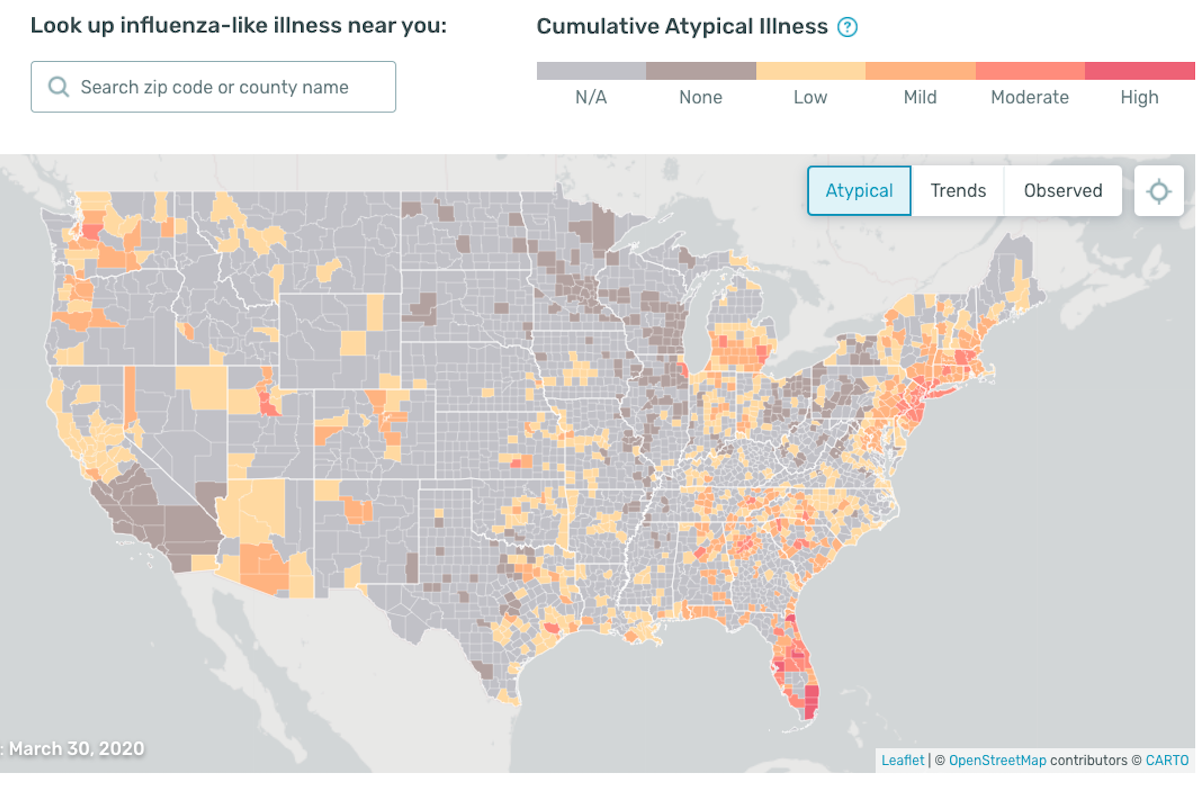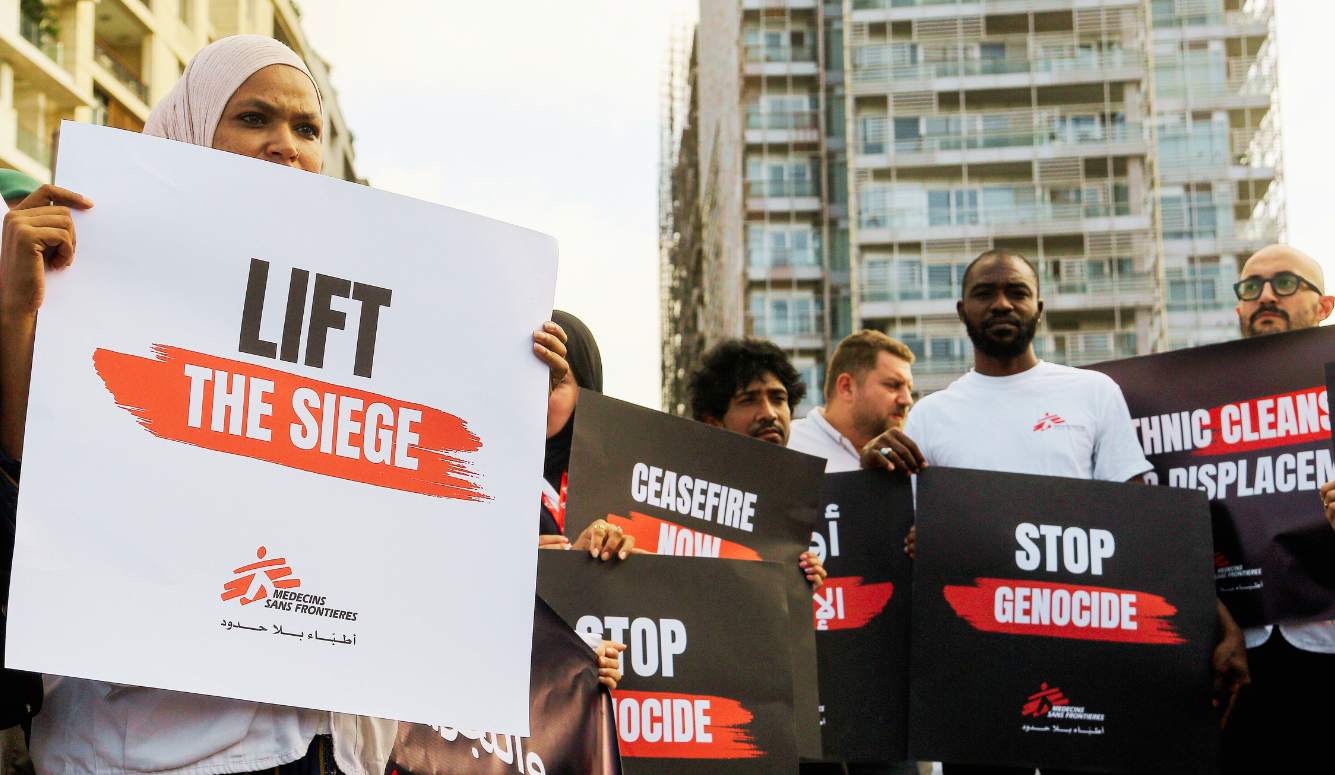COVID-19 Updates
COVID-19 Science Update for March 31st: Wear a Mask, Georgia's SSE, Kinsa's Fever Map
Both the scientific literature and media reports suggest COVID-19 transmission is most likely to take place (1) within families, and (2) through one-off SSEs of the type described above.

This article constitutes the March 31st, 2020 entry in the daily Quillette series COVID-19 UPDATES. Please report needed corrections or suggestions to [email protected].
Today’s data
According to statistics compiled by Our World in Data (OWD), the number of newly confirmed COVID-19 deaths increased yesterday.
The data, as reported by the European Centre for Disease Prevention and Control (ECDC), indicated 3,698 new confirmed COVID-19 fatalities globally, up from Monday’s newly reported deaths, of which there were 3,125. This included 418 new cases in France, 128 in Germany, 28 in Canada, and 661 in the United States—all of which represent new highs for these countries. Italy and Spain recorded 810 and 812 new deaths respectively, roughly equivalent to their average daily values over the last week. As usual, the four countries that consistently registered the most new deaths over the last three weeks—France, Italy, Spain, and the United States—accounted for almost three-quarters of all new deaths worldwide (73 percent).
One other statistical pattern worth noting: Yesterday’s drop in worldwide newly reported deaths—from 3,461 to 3,125—represented the second week in a row during which a decrease was reported on a Monday, followed by an increase on Tuesday. This may well be a coincidence. But given that these are the only two day-to-day global drops in newly reported COVID-19 deaths over the past two weeks, it also may reflect the anecdotally described phenomenon by which regional and national health authorities sometimes don’t formally report weekend deaths until Monday (which means they don’t get included in publicly listed tallies until Tuesday) .
Kinsa Health’s fever map
What is the best way to measure the extent of the COVID-19 pandemic? The two methods I have focused on in these updates—new cases and new deaths—both have flaws. The number of new cases, as I have stressed, is an artifact of testing, since more widespread tests (which we all want) mean more reported cases. (Moreover, something like 25% of cases may be completely asymptomatic.) On the other hand, we shouldn’t have to wait for people to die to track the spread of the pandemic. Several doctors have told me they believe tracking COVID-19-related ICU admissions would provide a valuable snapshot, but I am yet to find a comprehensive database that charts this index in multiple jurisdictions.
Another method involves corporate-culled metadata. A company called Kinsa Health, which produces web-connected thermometers, is now publishing (anonymized) stats that show which parts of the United States are exhibiting atypical feverish illnesses. The data is organized both by state and, nationally, by date.

What it shows is that atypical fever reports started climbing in late February, but then began dropping on or about March 20th, shortly after social-distancing policies became more widely adopted. Since death often follows diagnosis by about two weeks, this provides at least some hope that the United States will begin to see a decline in deaths during the first half of April.
Not too long ago, many of us were reading essays about how the “internet of things” might threaten our privacy rights. But with companies such as Kinsa supplying valuable metadata of this kind, and many citizens accepting more widespread intrusions into their personal lives, it seems likely that one of the legacies of the COVID-19 pandemic will be a less stringent approach to protecting both data privacy and civil liberties more generally.
A super-spreader event in Georgia
These reports do not typically focus on the individual human tragedies associated with COVID-19 statistics. But it is hard not to feel especially sympathetic to the residents of Albany, Georgia, part of a sparsely populated rural county that already has suffered 24 deaths. One extended family alone accounts for more than 20 cases.
I have repeatedly focused on the importance of COVID-19 “super-spreading events” (SSEs) in these updates—emphasizing how, across the world, they typically involve a large number of people engaged in unguarded forms of socially intimate behaviour in an indoor space. Typically, this involves religious, commercial, medical, or recreational activities that include lots of face-to-face contact, promiscuous social mixing, intense emotional experiences, or physical activity. The examples I’ve discussed include networking business conferences, sing-a-longs, a curling meet-up, a soccer game, concerts, evangelical worship sessions, a bat mitzvah, and, of course, medical clinics and old-age homes.
Among the most tragically common source of SSEs are funerals, since they include so many of the above-described elements. And the SSE in Albany provides a sadly perfect example, with about 200 mourners densely packed in a small-town funeral home to mark the loss of Andrew Jerome Mitchell, a retired janitor who had nine siblings. In the words of one attendee, “you hug and you kiss and you embrace.” This feels like the most natural way to express grief, yet these gestures proved a death sentence for several attendees. (The event also featured a “repast table crammed with casseroles, Brunswick stew, fried chicken and key lime cake.” It sounds delicious. But the very idea of the buffet itself may become outré in the post-COVID-19 era, at least for a while.)
Fully suppressing COVID-19 may prove impossible. But the evidence is strong that it can be substantially mitigated by avoiding large-scale activities of this type. Both the scientific literature and media reports suggest COVID-19 transmission is most likely to take place (1) within families, and (2) through one-off SSEs of the type described above. As yet, there is less evidence that it transmits systematically through guarded, socially distanced, hygienically-aware encounters of the daily variety you would expect in a store, office or classroom. And this pattern may provide a clue as to how we can gradually restore life to something approaching normal in coming weeks.

One of the reasons why so many of these SSEs created such a deadly chain reaction is that COVID-19 was little understood at the time, testing kits were few, and test results took a long time to be delivered. And so the original patient (or patients) often would spend days bouncing around the local health system, infecting more victims, before he or she finally was isolated and treated. Sadly, this was the case in Albany:
The man had chronic lung disease, and no history of travel that would suggest exposure to the coronavirus, and he was not put in isolation. [Hospital] staff members figured that he had just run out of oxygen. The man spent the next week in the hospital, attended by at least 50 employees, then was transferred on March 7 back to the Atlanta area, where he was tested for the coronavirus. Not until March 10 did the Albany hospital learn he had tested positive, Mr. Steiner said. He died on March 12, the state’s first coronavirus death.
Fortunately, this sort of thing would be much less likely to happen now, as there is obviously far greater awareness among doctors and the community at large—which provides us with hope that we already have seen the worst of the large SSEs.
Wear a mask
Finally, the evidence that mask usage will help save lives is now becoming overwhelming. As I have stressed, the emerging research indicates that the main physical delivery mechanism of COVID-19 is through large droplets expelled at above-average velocity, either by cough, sneeze, or by close face-to-face breathing and talking. COVID-19 does not seem to spread in the form of ultra-fine aerosol-based particles, and so you don’t need a medical-grade N95 mask to decrease the odds of infection or transmission. By using a larger-gauge fabric sieve, you don’t have to worry about depriving nurses of needed front-line equipment.
Unfortunately, many public officials, including Theresa Tam, my own country’s Chief Public Health Officer, continue to rely on policies that predate this new research. Lives are being put at risk as a result.
Much of the current science is summarized in this excellent column by Farhad Manjoo, who also explains how you can produce your own mask. He even links to a face-mask template so you will know how big to make it. And remember that there’s nothing to prevent you from being creative with your decorations. (Needless to say, the Times already has published a big piece on the leading fashion trends in this era.) I’m still working on my own creation, but if you have any particularly creative ideas to share, please send me your sketches.
A note to readers: This likely will be among the last COVID-19 science updates in this format. In coming days, I will transition to long-form interviews with medical specialists and researchers with expertise in areas related to COVID-19.






